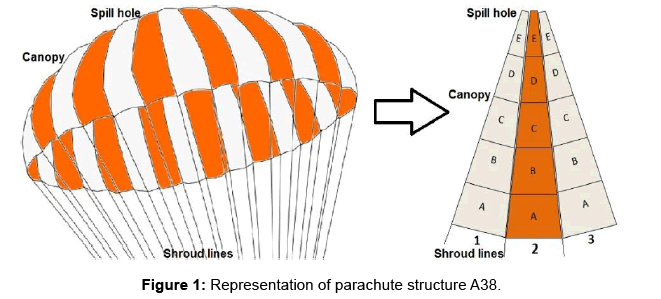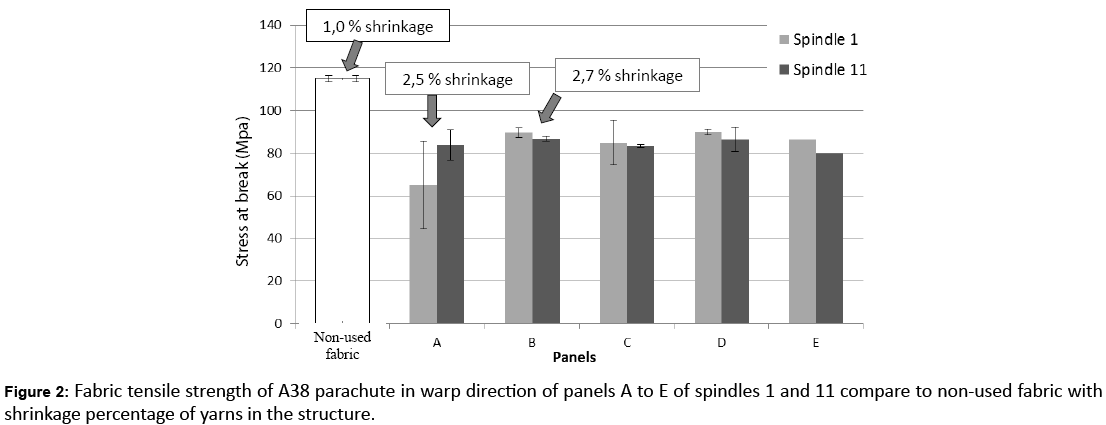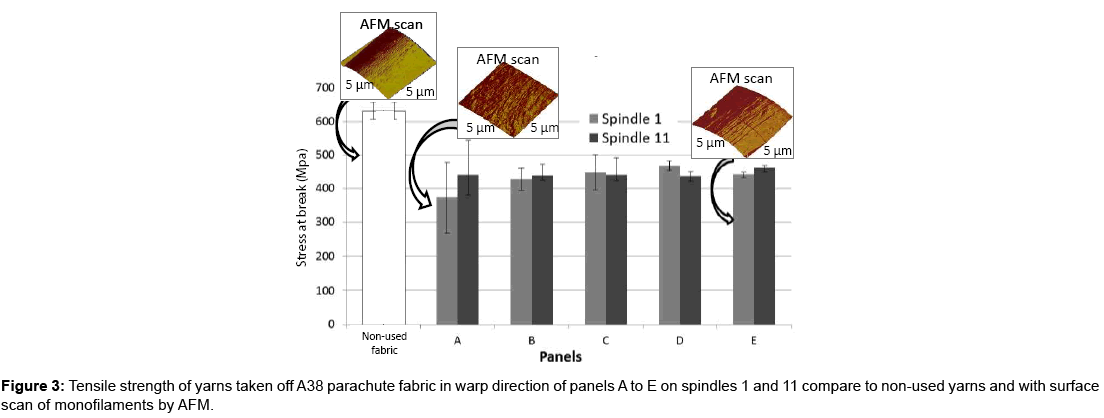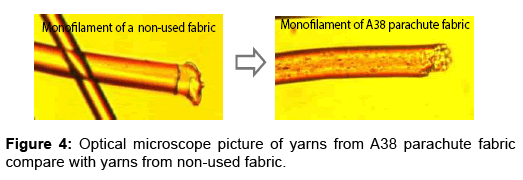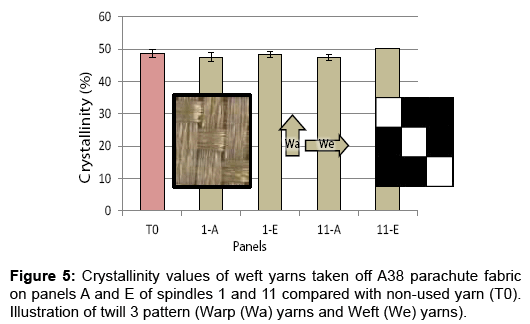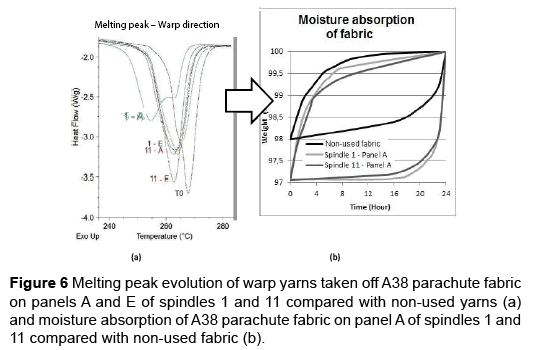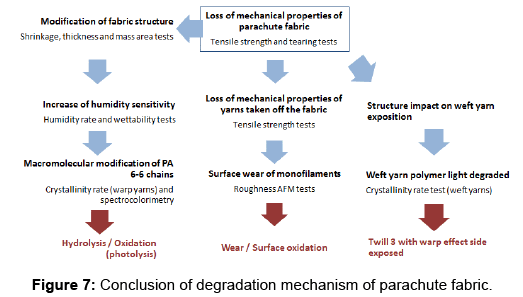Research Article, J Fashion Technol Textile Eng S Vol: 0 Issue: 0
Ageing Behavior of Polyamide 6-6 Parachute Fabric in Stratosphere and Troposphere Balloons Systems
Amandine Baltzinger1,2*, AurélieCayla1,2, Christine Espinosa3, Sophie Perraud4 and Christine Campagne1,2
1GEMTEX / ENSAIT, Roubaix, France
2University of Lille - North of France / Villeneuve d'Ascq, France
*Corresponding Author : Aurélie CAYLA
University Lille Nord de France, F-59000 Lille, France
Tel: +33 3 20 25 64 64
E-mail: aurelie.cayla@ensait.fr
Received: September 01, 2016 Accepted: December 05, 2016 Published: December 10, 2016
Citation: Baltzinger A, Cayla A, Espinosa C, Perraud S, Campagne C (2016) Ageing Behavior of Polyamide 6-6 Parachute Fabric in Stratosphere and Troposphere Balloons Systems. J Fashion Technol Textile Eng S2:008. doi: 10.4172/2329-9568.S2-008
Abstract
Parachutes are used to recover atmospheric measuring instruments and they are mainly made from polyamide 6-6 woven fabric. The objective is to identify modifications of mechanical and physicochemical properties of parachute along his lifespan. For this study, a decommissioned parachute has been characterized and compared to a non-used fabric. Results analysis showed a degradation of mechanical properties (tensile strength and tear) and a greater intake of moisture which alter the flight behavior. This is believed to be caused by the change in crystallinity content. The global fabric analysis showed that storage conditions have a significant impact on degradation.
Keywords: PA 6-6; Ageing; Parachutes; Mechanical properties; Thermal properties
Introduction
Scientific balloons are used to measure atmospheric composition and for astrophysics observations. The measuring instruments are recovered by one or three parachutes. A complete study must be done to certify the safety of the equipment for the duration of the mission. Other than the supplier’s certified lifespan, under “normal” use, current decisions to decommission a parachute are based on feedback from experiments rather than scientific expertise. However, under stratospheric use, knowledge earned last years is not enough to safely use the parachutes on nacelles recovery device. In addition, ageing of textile structure is a variable which makes anticipating flight performance more complex. A full analysis of parachute textiles will aims at better justifying their use and extending it.
For a safety use of parachutes, the mechanical continuity between the balloon and the measuring instruments chain must be insured. Parachute structures are complex and are made out of technical textile: mainly a polyamide 6-6 (PA 6-6) fabric. Many studies have been carried out on the ageing of PA 6-6 at ground level. However, few include the combination of stratosphere level parameters. During the flight, parachutes are subject to mechanical loads: high tensile stresses (static and dynamic), that can cause fatigue and creep. Repeated use of parachutes in their different life phases can also causes abrasion. Parachutes are also subject to harsh environments in the stratosphere and the troposphere: ozone, sunlight with UVC, low temperatures, and moisture. During storage, exposure to air, humidity, temperature and light is not controlled. Thus, flight cycles and storage will have a strong impact on polymer degradation. Parachute canopy fabric is made of polyamide 6-6 (PA 6-6). This polymer offers excellent features such as high strength, acceptable toughness, medium stiffness and maintains performance at high temperature (up to 180°C) [1,2]. This polymer is particularly interesting for the parachute canopy because it has a high impact resistance, and especially in case of repeated impacts. Polyamides also have a low coefficient of friction and a very satisfactory resistance on wear and fatigue [3,4].
Firstly, stratospheric parachutes are exposed to mechanical loads: stress and wear. Other mechanical degradation phenomena can be included in this study. Indeed, the parachutes loads succession induces mechanical fatigue and a possible creep of the material. In general, three kinds of rupture can be observed: brittle break, ductile break and the combination of both. The type of mechanical break depends on several physico-chemical parameters and on defects, naturally present in the polymer [5]. Polymers breaking strength by three mechanisms is describe also in three steps: damage, shear and cracking [6]. The energy dissipation in a fabric subjected to high tensile stress is mainly transmitted by sliding friction forces. These forces create important energy dissipation [7]. When yarns are expanded to their limit resistance, they reach a critical length. The higher the fabric density and the surface irregularity of yarns, the higher will be the critical length [8].
The wear measurement resistance of any material type is complex. Five types of wear phenomena on polymeric materials are identified: abrasion, adhesion, erosion, fatigue and fretting. Abrasion is one of the most common mechanisms because it is involved in 60 % cases of wear [9]. Abrasion is defined as scraping surface elements away by the action of hard particles in relative movement between two surfaces [10]. In our case, abrasion will scrap filaments on surface and will cause weakening of the woven structure. The parachute fabric is very thin in order to optimize the air intake against its folded volume. So it will be quickly weakened if filaments become abraded. The wear resistance of a fabric is affected by many factors, depending on the textile scale:
- at microscopic scale: the properties of the polymer, the size of the constituent molecules, the molecular orientation [11,12].
- at the mesoscopic scale: the method of production of the thread, the constitution of the yarn (number of filaments and section), ductility and surface condition [11-13].
- at the macroscopic scale: the type of finish applied beyond the glass temperature (Tg) of the material (dye, heat setting, calendering, etc.) [11,12], density, thickness, pattern, tensile modulus and the breaking time of fabric rupture under stress [13].
Polyamides, under constant loads for a long period, may be subject to creep phenomena. Creeping is characterized by an immediate deformation of the polymer followed by a slowly increasing permanent deformation under constant load. Tensile creep performance depends on deformation speed of the polymer, supported load and high temperature exposure time. In our case, textile elements undergo a high load at low temperature (below 0°C). Therefore, only the sliding of macromolecular chains in the amorphous areas is possible. That will cause permanent deformation of the structure but the behavior of the fabric at strength will be the same [14]. Temperature has a very significant effect on the mechanical behavior of polymers, especially on fatigue. At moderate temperatures (under 55°C), the polymer is in the glassy state. In this state, the weak inter-macromolecular bonds (van der Waals forces) are higher than above the Tg [15]. The movement in between macromolecular chains is restricted and the elongation is low. The higher the temperature, the higher the deformation at break will increase. Above the Tg, the polymer rigidity decreases and will reduce cracks [16,17]. As in the previous mechanical degradations, water also has a very important role in fatigue. Indeed, absorption of water increases the spacing between the macromolecular chains and makes the polymer more ductile by plasticizing. The polymer deforms easier under stress without being more resistant, which limits the fatigue endurance. Material fatigue will be initiated by micro-defects, which would normally require a higher load [18].
These parachutes are exposed to extreme environmental conditions in stratosphere (from 12 to 50 km altitude) and troposphere (from 0 to 12 km altitude). In the stratosphere, ageing parameters are: ozone, light (with ultraviolet A, B and C) and temperatures from -50°C to -90°C [19,20]. In the troposphere, ageing parameters are: air, moisture, light (ultraviolet A and partially B) and temperatures from -20°C to +30°C. Majority of the atmosphere (75 wt.%) is in the troposphere, between 0 and 12 km altitude. Air of the atmosphere causes surface oxidation. Oxidation is the most important degradation process of hydrocarbon polymers [1,21]. The oxide layer thickness is from 400 to 500 microns at 110°C in air for PA 6-6 [22]. In addition, the small section of multi-filaments textiles provides a large contact area with air. The oxidation causes a fast decrease of elongation at break depending to ageing time, which may be due to chain cuts [23]. Oxidation reactions are generally slow at glassy state (T<Tg), because a molecular mobility enhances the oxidation propagation [24]. Temperature is an oxidation accelerating factor, oxidation effects nearly disappear below 20°C [25]. Polymers with carbon molecules, as PA 6-6, are the most sensitive to ozone, because it is as much chain scission sites by ozonolysis [26]. PA 6-6 degradation by ozone can cause cross linking between macromolecular chains, preventing these chains to move to each other [27,28]. Ozone causes irreversible cracking of the structure [24]. Oxidation by ozone on PA 6-6 is not properly documented to allow us to infer the importance of its degradation process. Humidity is very present below 12 km altitude. PA 6-6 is hydrophilic polymer and absorbs 4.3% of its weight in water at 20°C, so it is very sensitive to moisture [29]. Hydrolysis is a chain scission mechanism causing a decrease of molar mass, which induces a decrease of mechanical properties of the material [28]. During water exposure of PA 6-6, the tensile strength loss and the decrease of elongation at break is higher [30]. Hydrolysis causes more or less reversible swelling in the polymer, involving a greater molecular mobility, a relaxation of residual stresses and morphological rearrangements [31]. Thus, water acts as a plasticizer for the PA 6-6 [32]. Hydrolysis effects will have little impact on ageing of PA 6-6 below 20°C [25,33].
Temperature is a parameter of ageing acceleration by thermaloxidation, ozonolysis and hydrolysis processes [34]. The higher the temperature, the higher the mobility of macromolecular chains will be elevated, and particularly for PA 6-6 which have a low glass temperature of 55°C [2]. Thermal oxidation causes a decrease in weight, a reduction of the molar mass, cracks on fiber surface, yellowing, loss of tensile elongation, etc. Prolonged exposure to temperature will induce progressive degradation, and then a total and permanent loss of the fiber crystallinity [34]. During stratosphere missions, parachutes are exposed to sunlight. Ultraviolet B (UVB) and C (UVC) are not filtered and are a part of the most harmful solar spectrum. The degradation phenomenon by sunlight is photolysis. Photolysis is a major factor of degradation because impurities in the polymer and the polymer itself can absorb light and produce free radicals. Free radicals are responsible for the chain decomposition reactions, which can seriously degrade the PA 6-6 without stabilizers [35]. PA 6-6 fibers are especially sensitive to 340 nm wavelength [36]. The chains breaking in the polymer will be different depending on the exposure wavelength: the λ ≤ 340 nm cause breakdown of CONH bonds, and λ ≥ 340 nm cause breakdown of C-H bonds [37]. The ultraviolet radiation creates strong degradation of polymers as the photon energy is the same order of magnitude as the energy of the chemical bonds. However, these bonds ensure the cohesion between the macromolecules. Exposure to sunlight causes a loss of crystallinity rate and a decrease of molecular weight of polyamides [38,39]. Environmental degradation, in majority of cases, occurs above 20°C. This temperature can be reached during storage. Even if moisture, temperature, sunlight and air act in synergy on polymer ageing, the combination of these parameters will be limited by low temperatures in use. Very little information is available on textile structures after ageing, which justifies in this study a particular interest.
First, the objective is to identify the changes of mechanical properties of parachute fabric on macroscopic scale. Then, additional physico-chemical tests will allow us to understand the causes of these changes on mesoscopic and microscopic scales. Besides, a focus will make on specifics areas of damage on the parachutes canopy.
Experimental
The study focused on the fabric of the canopy, the largest element of the parachute. The parachute canopy is composed of two colors: orange and ecru. This study focused on the ecru fabric, which is mainly present on hemispherical parachutes. For this study, two decommissioned parachutes have been characterized and compared to a non-used fabric, which is the reference point. The first step is to identify the changes in the mechanical properties of structural members. These properties are essentials to maintaining the mechanical chain continuity and influence directly the physical parachutes properties in flight. The second step is to identify the causes of the changes in the properties of the fabric at the mesoscopic and microscopic scales with additional physico-chemical characterizations.
Materials
Stratospheric parachute studied is called A38. This parachute is hemispherical, commissioned in 1968 and used for flights up to 38 km altitude. The parachute canopy is formed of 18 spindles zones, 9 ecru and 9 orange. Each zone is composed of 5 panels rated from A to E, where E is the closest panel to the spill hole (Figure 1).
Parachute fabric is formed of a twill 3 weave, composed of PA 6-6 high density multifilament. For each non-destructive tests (thickness, mass density, spectrocolorimetry, etc.) an average of 10 measurements have been done on each panel of each ecru spindle. For each destructive tests (tensile strength, tear), as far as possible, an average of 10 measurements have been done on each panel of each ecru spindle.
Characterization tests
At the macroscopic scale, corresponding to the fabric scale, the following tests are performed: uniaxial tensile strength on fabric, tear, thickness, mass density, wetting, spectrocolorimetry, shrinkage, and moisture absorption rates.
The uniaxial tensile strength was done on fabric (norm NF EN ISO 13934-1) at speed 100 mm/min with MTS machine on samples 200 mm long and 50 mm wide. The tearing (norm NF G07 146) was done at speed 100 mm/min with MTS machine on samples 210 mm long, 50 mm wide with a slot of 80 mm in lengthwise sense. The thickness measurement (norm NF EN ISO 5084) was done under 1 kPa weight with Sodemat machine. The mass density measurement was done with an accurate balance to the nearest 0.1 g on tensile strength samples. The wetting test was done with drop test angle meter machine. This machine measures the angle contact between the fabric and distilled water drop of 15.10-3 mg. The color measurement by spectrocolorimetry was done with the Datacolor FS600 machine, calibration 0% UV, 30 mm lens aperture, and a specular "excluded". The measurements were performed on 10 plies fabric. The shrinkage is defined as the crossing of the warp with the weft yarns. It consumes length and this difference is expressed in percentage. The E shrinkage increases with the weaving density (string into account). It is defined as a percentage as E = (L-L0)/L0*100 where L0 is the length of yarn in the fabric and L is the length of the straight yarn. The moisture absorption rates are measured in fabric samples of 40 g with an accurate balance to the nearest 10-4 g placed in a climatic chamber. The climate chamber is adjusted to 30°C and 18% relative humidity for desorption phase. The chamber is set to 20°C and 65% relative humidity for sorption phase. Measurements of sample mass are made on cycles of 24 h.
At the mesoscopic scale (yarns scale), following tests are performed: uniaxial tensile strength on yarns and microscopic analysis. The uni axial tensile strength on yarns (norm NF EN 13895) was done at speed 200 mm/min with Zwick machine on samples 200 mm long. Microscopic analyses were obtained from a digital camera Axiolab Pol from Carl Zeiss coupled to the stereomicroscope. This image is then processed using the Clara Vision Perfect-Image software.
At the microscopic scale, corresponding to the scale of the polymer (PA 6-6), following tests are performed: crystallinity measurement by differential scanning calorimetry (DSC) and analysis by atomic force microscope (AFM). DSC characterizations of each multifilament were performed on a 2920 Modulated DSC (TA Instruments) with typically 5 ± 0.1 mg of material. The manipulation carried out under nitrogen atmosphere (with a flow of 50 ml/min) consists in one cycle: from −20°C to 200°C at 10 K/min, an isotherm at 200°C during 5 min and the cooling scan at 10 K/min to return at −20°C. Melting enthalpies (ΔHm) and temperatures (Tm) were determined from the heating scan, while crystallization enthalpies (ΔHc) and temperatures (Tc) were evaluated from the cooling scan. The crystallinity degree (χ) of PA 6-6 was calculated according to Eq. (1):
![]() (1)
(1)
Where ΔHm0 is the reference enthalpy defined as heat of a 100 % crystalline sample.
Monofilament surface scan by atomic force microscope (AFM) was done with "Nanoscope III" Digital Instrument machine equipped with a fine tip at the micron scale and scanning the sample on a square 6 × 6 microns.
Results and Discussion
The effectiveness of a stratospheric parachute is assessed by its ability to slow down the fall, the charge capacity, its own weight, its stability to temperature and humidity, and its lifetime. For an optimal use of parachute, the following parameters of the canopy have an important role: dimensions, air permeability, fabric thickness, strongest structure, stability of polymer to temperature, and the resistance of the polymer to use conditions. The goal is to characterize the decommissioned parachutes named A38 and compare it to a non-used fabric. The results are presented on the spindle 1, the most exposed during storage, and the spindle 11, a non-exposed during storage.
Mechanical properties at microscopic scale
Firstly, the observation of the fabric during tearing tests demonstrates that the stress is not distributed in the structure but yarns work and break individually for the parachute fabric. Indeed, degradation is equivalent in the warp and in the weft direction with a loss of 56% of the maximum force and the amplitude. Therefore, the tearing resistance is independent of the structure and comes from yarns degradation.
Then, the fabric tensile tests of the structure show a general loss of mechanical properties in Table 1 (strength, elongation and modulus). A higher loss of breaking and elongation strain is measured in the weft direction than in the warp direction. The fabric production method requires the weft yarns to intersect the warp yarns for the best organization in the fabric. The weft yarns are more stressed during the use because this configuration causes shear stress and induces larger lesions. Therefore, the modification of mechanicals properties is different in the warp and weft direction, which indicate an influence of both structure and yarn behavior in ageing. The panel A of spindle 1 has the lowest tensile resistance in warp and weft direction and is the most heterogeneous panel (Figure 2).
| Test | Parameters | Warp direction | Weft direction |
|---|---|---|---|
| Tensile Strength | Stress at break σ (MPa) | ↘ 27 % | ↘ 34 % |
| Elongation at break ε (%) | ↘ 9 % | ↘ 19 % | |
| Modulus E (MPa) | ↘ 67 % | ↘ 12 % |
Table 1: Mechanical properties loss of parachute fabric compare with non-used fabric.
In Figure 2, the shrinkage test show a rearrangement of the structure with a stretching of weft yarns at the expense of warp yarns. This structure modification comes from an equivalent mechanical stresses in weft and warp direction whereas the warp yarns direction is usually positioned in the direction of the principal stresses. The stretching of the weft yarns structure explains a loss of elongation into the fabric. The shrinkage test confirms that the damage comes from the structure in ageing because of the movement of yarns in the structure.
Mechanical properties at mesoscopic scale
Yarns tensile strength tests indicate a 30% loss at break for both warp and weft directions (Figure 3). The difference with the loss of fabric properties confirms that degradation of yarns is not the only factor which affects the properties of the fabric. In weft direction, a decrease of 15 % elongation and an increase of 16 % modulus indicate that yarns become more rigid. In warp direction, yarns are less rigid because tests show an increase of 21 % elongation with a decrease of 38 % modulus. This difference in behavior between the warp and weft yarns can be due to polymer degradation and will be specified by polymer analysis.
The strength loss at break of the weft and the warp yarns may be due to a same type of degradation. The high sharp yarn deterioration observed by optical microscope, Figure 4, showed that, for the nonused fabric, the surface passes from smooth and transparent to an opaque surface for the used fabric. Also, examination of the fracture surface indicates a more brittle behavior of yarns with ageing. This surface degradation has been confirmed by the monofilaments surface scanning by AFM tests observable on Figure 3.
Moreover, the surface scanning by AFM confirmed the evolution of the surface after ageing. We measured an increase of 72 % in surface roughness of monofilaments at the nanometer scale. Therefore, yarns of parachute fabric undergo surface degradation which induces stress concentration points and initiate failure.
Chemical properties at microscopic scale
The evolution of yarn properties also depends on modifications of inherently polymer properties. On one hand, the calorimetric test by DSC on the weft yarns, show a negligible loss of crystallinity rate compared to non-used weft yarns, which indicates no modification of the polymer (less than 5 %) as illustrated in Figure 5. Minor degradation of the weft yarn polymer may be due to partial protection of weft yarns by the warp yarns from external attack. Indeed, with twill 3 with warp effect side exposed, the weft yarns are only half exposed to the environment (mainly UV) and thus less degraded than the warp yarns. Therefore, the structure causes a weaker environment exposition and a higher inner mechanical stresses on the weft yarns compared to the warp yarns. On other hand, crystallinity tests, on the warp yarns, show a decrease in crystallinity and an evolution of the peak shape (Figure 6 (a)). The evolution of the peak shape indicates a polymer crystallinity modification. This modification may be explained by the chains cleavage or/and chain size decrease, due to the ageing. This could be verified by molecular weight measurement.
Yarn tensile tests show that warp yarns are less resistant but are more flexible, which facilitates their elongation capacity and implies a reduction of the modulus (part 3.2). The crystallinity part of a polymer has a low sensitivity to external degradation, and increases the mechanical strength of a polymer. Therefore, a reduction of crystallinity rate causes a greater elongation of yarns.
This chemical structure modification lets further opportunities for water molecules to react with PA 6-6 macromolecular chains, causing a hydrolysis. In addition, the crystallinity loss in warp yarns allows the polymer to absorb more moisture (Figure 6 (b)), because it is in the amorphous phase that the water is inserted into the polymer which fosters the hydrolysis effect. Chemical bonds that break during the polymer degradation may come from photolysis and oxidation confirmed by a yellowing of the fabric measured by spectrocolorimetry. Spectrocolorimetry test ensures a measurement of the global color difference. The highest global color difference is 6.9 according to CIE Lab standard and was measured on panel A of spindle 1. The surface degradation observed on AFM tests may be due to polymer surface oxidation.
Chemical degradation allows greater surface contact with the outside environment, thereby promoting oxidation of the polymer surface. Indeed, the loss of crystallinity in the warp direction and the increase of the filaments surface roughness make the polymer more hydrophilic.
Physicals properties at microscopic scale
Wettability measurements (contact angle in between the water and the surface of fabric) show an immediate absorption of the drop on aged fabric while a drop takes 5 minutes on a non-used fabric. It confirms a greater ability of the fabric to absorb water, as with the moisture absorption rate test. A greater moisture intake rate of the polymer causes an increase of fabric thickness and mass density of 6 %. This structure modification impacts on fabric tensile properties.
Finally, the results showed that the ageing of the parachute may induce a greater intake of moisture in the polymer. Further tests on other parachutes are needed to validate this hypothesis, but this type of degradation would explain the loss of parachute performance due to ageing. Indeed, if the parachute fabric absorbs more moisture, they become heavier and therefore have a bigger burden to bear which limits their effectiveness.
Conclusions
Results show an overall loss of mechanical properties of the fabric. The global fabric analysis showed a higher degradation on the spindles 1 and on the panels A. Panel 1-A being the most exposed during storage, therefore the storage have a significant impact on degradation.
Further tests on other parachutes are needed to validate hypotheses resumed in Figure 7. These types of degradation phenomena would likely explain the loss of parachute performances during their lifespan. Indeed, if the parachute fabric absorbs more moisture, they become heavier during the mission which limits their effectiveness. Finally, results analysis showed a loss of tensile strength and tear properties; and a greater intake of moisture which alter the flight behavior. These modifications are mostly due to hydrolysis, surface oxidation and photolysis which induce chain cutting and crystallinity rate modification. The global fabric analysis showed a higher degradation on the most exposed part of the parachute during storage, indicating that storage conditions have a significant impact on degradation.
In perspective, characterization of other stratospheric parachutes is essential to valid the last hypothesis. Then, artificial ageing is expected to control each parameter and identify the individual and synergic effect. Artificial ageing will allow us to identify the major degradation parameter. Other parts of the parachute can be study: suspension line, ribbon between spindles, seams, etc. In the end, simulation of fabric degradation in canopy could be done to understand the effect of textile ageing on parachutes.
References
- DuPont™, Minlon® (2002) Guide des produits et de leurs propriétés, résine polyamide renforcée mineral H-53824-1.
- Greco R, Nicolais L (1976) Glass transition temperature in nylons. Polymer 17: 1049-1053.
- DuPont™, Minlon®, Zytel® (2001) Conception des pièces – Module II, résines polyamides E-56843-1.
- Bernasconi A, Davoli P, Rossin D, Armanni C (2007) Effect of reprocessing of fatigue strength of fiber glass reinforced polyamide. Composites Part A. 38: 710-718.
- Haudin JM (2006) Mise en forme des polymers. Matériaux pour l’ingénieur : solidification. Ecole des Mines de Paris, France.
- Schirrer R (1995) Introduction à la Mécanique des Polymères. Mécamat-GFP, INPL 395-411.
- Nilakantan G, Gillespie JW (2012) Ballistic impact modeling of woven fabrics considering yarn strength, friction, projectile impact location, and fabric boundary condition effects. Composite Structures 94: 3624-3634.
- Chen G, Ding X (2006) Breaking progress simulation and strength prediction of woven fabric under uni-axial tensile loading. Text Res J 76: 875-882.
- Neale MJ, Gee M (2001) Guide to wear problems and testing for industry. William Andrew Publishing, New York, USA.
- Ibanez JM, Gilabert J, Vincent M, Gomez M, Munoz D (2009) Determination of the wear resistance of traditional ceramic materials by means of micro-abrasion technique. Wear. 267: 2048-2054.
- ASTM (2007) Standard guide for abrasion resistance of textile fabrics (rotary platform, double-head method).
- Cayer-Barrioz J, Mazuyer D, Kapsa P, Chateauminois A, Robert G (2004) Abrasive wear micro mechanisms of oriented polymers. Polymer 45: 2729-2736.
- Unal H, Sen U, Mimaroglu A (2005) Abrasive wear behaviour of polymeric materials. Materials and Design. 26: 705-710.
- DuPont™, Minlon®, Zytel® (2001) Conception des pièces – Module II, résines polyamides. E-56843-1.
- Mouhmid B (2007) Etude de l’endommagement et rupture d’un polyamide 66 chargé aux fibres de verre courtes. PhD Thesis, Université des Sciences et Technologies de Lille, France.
- Yongshou L, Zongzhan G, Wei L, Zhufeng Y (2008) Analytical and experimental investigation of fatigue crack propagation for polyethylene methacrylate. Material Science and Engineering: A 486: 363-368.
- Bellemare S, Dickson I, Bureau M, Denault J (2005) Bulk fatigue damage evaluation in polyamide-6 and in a polyamide-6 nanocomposite. Polymer Composite. 26: 636- 646.
- Barbouchi S, Bellenger V, Tcharkhtchi A, Castaing P, Jollivet T (2007) Effect of water on the fatigue behavior of a pa66/glass fibers composite material. J Mater Sci 42: 2181-2188.
- AMETEK (2013) Les fondamentaux du Vieillissement climatique – Niveau I. ATLAS.
- Dauphin-Pierre S, Ghannoum K, Sobolewski C (2014) L’atmosphère : composition. La science derrière l’effet de serre.
- Zweifel H (2001) Plastics additives handbook. Hanser Gardner Publications, Munich, Germany.
- Ahlblad G, Förström D, Stenberg B, Terselius B, Reitberger T, et al. (1997) Oxidation profiles of polyamide 6,6 studied by imaging chemiluminescence and FTIR. Polymer Degradation and Stability 55: 287-293.
- Dong W, Gijsman P (2010) Influence of temperature on the thermo-oxidative degradation of polyamide 6 films. Polymer Degradation and Stability 95: 1054-1062.
- Woishnis WA, Ebnesajjad S (2012) 19: Nylon 66 (PA66). Chemical Resistance of Thermoplastics.
- El Mazry C (2013) Durabilité de Produits Innovants de Robinetterie en Polyamide 6-6. Spécialité Mécanique-Matériaux, École Nationale Supérieure d'Arts et Métiers, PhD Thesis, Paris, France. 2013.
- Geletneky C, Berger S (1998) The mechanism of ozonolysis revisited by 17O-NMR spectroscopy. European Journal Organic Chemistry 1625-1627.
- Verdu J (2002) Vieillissement chimique des plastiques : aspects généraux. Techniques de l’Ingénieur.
- Rabek JF (1994) Polymer photodegradation. Mechanisms and experimental methods. Springer Science & Business Media, London, UK.
- Angelloz C, Caramaro L, Laine P, Vaija J (2005) Comportement au vieillissement de fibres textiles synthétiques. IRNS.
- Bernstein R, Derzon DK, Gillen KT (2005) Nylon 6.6 accelerated aging studies I: thermal–oxidative degradation and its interaction with hydrolysis. Polymer Degradation and Stability 88: 480-488.
- Gonçalves ES, Poulsen L, Ogilby PR (2007) Mechanism of the temperature dependent degradation of polyamide 66 films exposed to water. Polymer Degradation and Stability 92: 1977-1985.
- Fayolle B, Verdu J (2005) Vieillissement physique des matériaux polymers. Techniques de l'ingénieur.
- Bernstein R, Gillen KT (2010) Nylon 6.6 accelerating aging studies II: Long-term thermal–oxidative and hydrolysis results. Polymer Degradation and Stability 95: 1471-1479.
- Jain A, Vijayan K (2002) Effect of thermal ageing on Nylon 6,6 fibres. J Mater Sci 37: 2623-2633.
- Guérin B (1994) Polyamides PA. Techniques de l’Ingénieur, Plastiques et Composites A.
- Angelloz C, Laine P (2004) Etude du vieillissement des produits textiles de type sangles, élingues et cordes toronnées Comportement au vieillissement de fibres textiles synthétiques. INRS, IFTH.
- Lemaire J, Gardette JL, Rivaton A, Roger A (1986) Dual photo-chemistries in aliphatic polyamides, bisphenol-a polycarbonate and aromatic polyurethanes - a short review. Polymer Degradation and Stability. 15: 1-13.
- Thanki PN, Singh RP (2002) Photostabilization of Nylon 66 in presence of acid blue dyes. Polymer Degradation and Stability. 75: 423-430.
- McKeen LK (2006) The effect of UV light and weather on plastics and elastomers, 7 Polyamides Nylons. William Andrew, New York, USA.
 Spanish
Spanish  Chinese
Chinese  Russian
Russian  German
German  French
French  Japanese
Japanese  Portuguese
Portuguese  Hindi
Hindi 